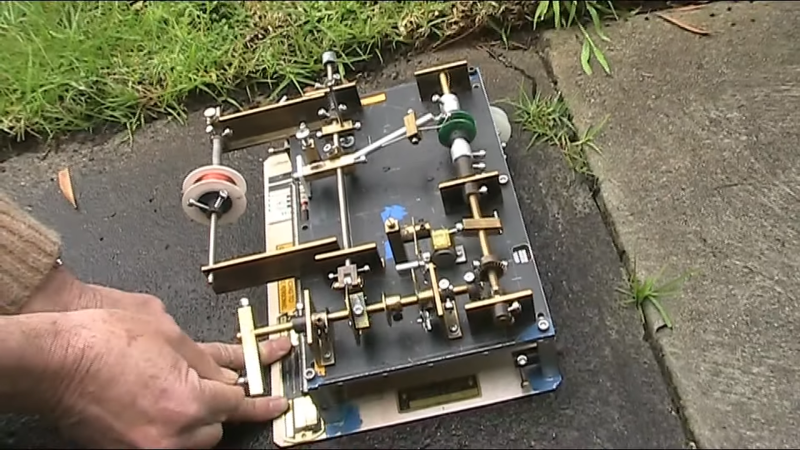If there’s something more tedious than winding coils, we’re not sure what it is — possibly rolling and wrapping coins; that’s really a bother. But luckily, just like there are mechanical ways to count coins, there are tools to make coil production a little less of a chore, but perhaps none that have as much charm as this all-mechanical coil winder.
We’d say that [Ralph (VK3ZZC)]’s amazing invention firmly falls under the “contraption” category, without a hint of the term being used as a pejorative. The rig was based on the MoReCo Coilmaster, a machine that was once commercially available at a fairly steep price, according to [Ralph], and still seems to command a premium even today. Never being able to afford an original, [Ralph] spun up his own from scrap metal and tooling no more sophisticated than a drill press. It’s a riot of brass and steel, with a hand crank that drives the main winding shaft while powering a cam that guides the wire along the long axis of the coil form. Cams can be changed out for different winding patterns, and various chucks adapt to hold different coil forms to the winding shaft.
There are a ton of interesting details in the build, which [Ralph] explains over on fellow ham [Peter (VK3YE)]’s YouTube channel — video below. The neatest idea is a reservoir attached to the wire feed tube that holds beeswax. The wire gets coated with wax as it feeds out to the coil, serving not only to lubricate things a bit but also to provide some tackiness to encourage the magnet wire to stay in place on the coil form. It’s a lovely detail, although [Ralph]’s source for the wax — the coating from a block of cheese — isn’t exactly appetizing.
We’ve seen coil winders before, but most of them are motorized and Arduino-fied affairs. Not that there’s anything wrong with that, but seeing an all-mechanical solution in action is pretty cool too.

















There’s also the winder from the Morris Gingery books: https://youtu.be/FIOocMoRsYQ
First thing I thought of. Dave Gingery published his book in 1991: https://gingerybookstore.com/CoilWindingMachine.html
I’m thinking the winder in a fishing rod.
Ralph has a wonderful, retro style, blog page here: https://users.monash.edu.au/~ralphk/
Now for an encore, make something really useful – a toroid winder.
I find winding toroids to be relaxing and akin to knitting. Whilst I never look forward to the task, completion brings simple joy.
Back “in the day” (5 years ago?) I used a door handle as a tool to wind an air coil for longwave. It had a few hundred turns. It took a while, but at the end it had no knots whatsoever.
Back in the late 70s Model Engineer magazine published an article by Rex Tingey on an attachment for a Unimat desktop lathe to wind transformer coils and the like. A microswitch was activated on each revolution of the headstock pulley. This was wired to the ‘=’ key of a pocket calculator. After entering ‘1+=’ the calculator would count up on each press, then mentally subtract 1 when done.
That’s the same trick used by poor kids who couldn’t afford a proper bicycle computer (aka odometer, cyclometer etc). They wired their tire sensor (switch, say reed contact+magnet) to the = button.
I use the same approach when counting rubber motor winds. The height of Rubber free flight technology.